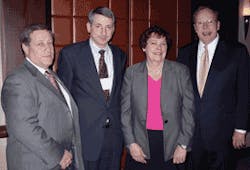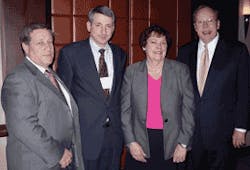The Generation Gap
On a relatively warm, snow-free February night in Chicago, during the most recent Midwinter Meeting, Sunstar Butler hosted a consortium for the leadership of the 12 major organizations of our dental profession. This was the eighth such meeting generated by Sunstar Butler to forward the goals of dentistry. Their focus on the state-of-the-art link between oral and systemic health and the quality of life has been the driving force of these meetings.
Sunstar Butler’s sole focus is to support dentistry and its mission. There is a high level of respect for their business partnership with our profession. With their unique focus on personal oral hygiene devices, they address individual patient needs through professional feedback. Although it isn’t the largest company, its heart is in the right place. As an active leader in personal oral hygiene products, Sunstar Butler has taken on the challenge of the individual patient. Through communication with the profession, they provide products that are practical for our patients. Click here to view Workplace Characteristics
Sunstar Butler has become an integral component in dentistry, not only for their professional products, but as an emerging leader in expanding the education of the dental community. As one of the first companies to open communication with the dental community, they began dialogues on the concept of a correlation between oral and systemic health. They have generated discussions of a paradigm shift between the care and health of the mouth to the overall health of the body, as well as systemic issues that impact the body. Over the past seven years, topics have ranged from wellness, aging, periodontal disease, low birth weight babies, and diabetes to evolving oral health issues. These research topics were presented to the leaders of our profession by a wide range of highly respected organizations. These meetings have sparked further research and conversation.
This year, the group was honored by the presence of Ms. Marilyn Moats Kennedy, who discussed the evolution of the workforce and how it will not only affect future generations of our profession, but how it will impact organizations that rely on membership for survival. The program, titled “Managing the Cross-Generational Dental Association,” struck a chord with all of those present.
With age diversity being the great divide, Ms. Moats Kennedy described the current workplace as consisting of four distinct age categories, with a fifth on the horizon. Ms. Moats Kennedy discussed the differences between these age groups, the basis for the differences, and the possible impact on the future of organized dentistry and other volunteer groups that affect dentistry. As newer generations enter the profession, there comes the challenge of delivering the message of sustaining continuity through membership in professional organizations. What may have created interest in professional membership for one generation could be a complete turn-off for another. How do we maintain the vitality of our societies if there is not a shared vision?
The message was clear. We cannot approach everyone in the same way. What is of interest to a Boomer in a professional society may not be of interest to a new dental school graduate, who has loads of debt and the unclear concept of “what will you do for me?” Just as we can’t deliver the same message to everyone in the same manner, we also cannot speak to everyone in the same way. Continuing education seems to be one of the driving forces of interest between all age groups. We were challenged to find ways to make continuing education a key perk. Even though everyone may have diverging interests, from the computer-challenged to the computer wizards, we all need those courses to maintain our licensure.
There are no specific items that will offer universal appeal and encourage participation, although mentoring was considered an effective strategy. Each generation learns from the next. Our organizations need to find ways to incorporate the communication of anecdotal and technical information to others, in a format that they are able and willing to receive. The Busters and Cuspers may not be interested in volunteering, as they feel they “did their time” during dental school. They are not interested in teamwork, large group meetings or participation, but if we can appeal to them with mentoring and access to unlimited information that will further their professional success, we may generate enthusiasm. The draw of multiple agendas, some hands-on, and some more technically savvy, may attract new interest.
How do we translate this information to our professional lives? One of Ms. Kennedy’s key points was mentoring. All new generations crave information. To create successful transitions, we must establish a mentor atmosphere. By offering team meetings to exchange information regarding practice protocol, treatment options and modalities, we pass on practical information between the various groups.
But, this does not occur without roadblocks. There is a dichotomy in communication skills between younger (1960-1984) and older (1935-1959) practitioners. The Cusper and the Busters like to work alone, have a blunt style approach, may have more abrupt speech patterns, and desire results quickly. The Boomers and their predecessors prefer to work as a team, have a more softened style of approach, prefer to process and talk about ideas and issues, and value consensus. Communicating between these generations involves giving a message that everyone can understand.
Technology appears to be the great equalizer. The Busters have used technology for years; they are not afraid of it, rather they embrace it. Some of the Boomers are still hesitant to leap into the new dental technological world. The Busters are able tutors in this realm. We need to build on this mentoring and encourage all members of the team to complement each other with knowledge, and to create excellent working systems within the office.
No one said recruitment was easy. But recruiting new members and sustaining existing members is as important to the health of a dental organization as it is to the health of a dental practice. Sunstar Butler’s commitment to the health of the profession through the sponsorship of these consortiums is highly evident. The more information we have to work with, the stronger the link between future generations of dental professionals and associations.
The author wishes to thank John Hennessy, VP Sales and Marketing, Sunstar Butler, for his assistance.
Sheri B. Doniger, DDS, has been in the private practice of family and preventive dentistry for more than 20 years. A dental hygiene graduate of Loyola University prior to receiving her dental degree, her current passion is focusing on women’s health and well-being issues. She may be contacted at (847) 677-1101 or [email protected].

